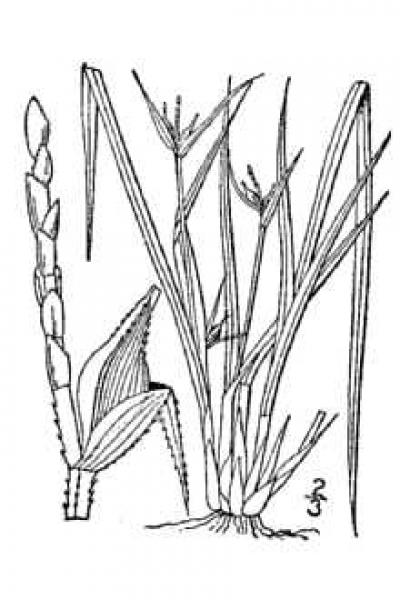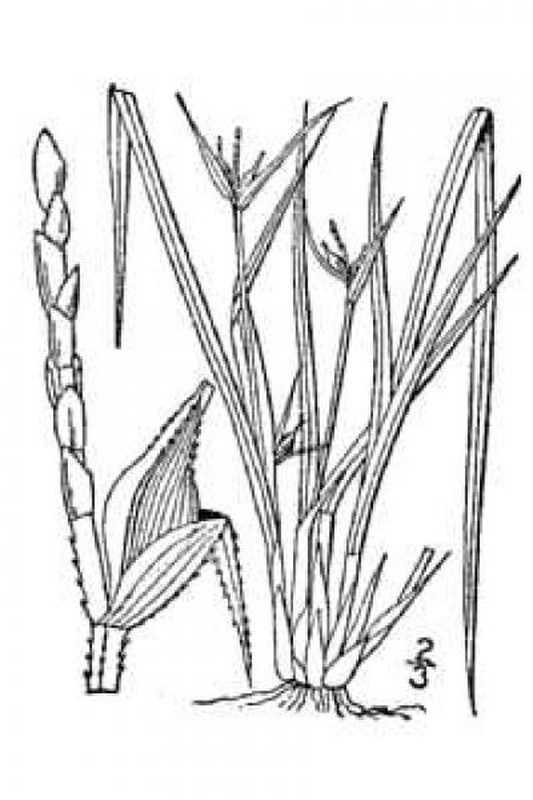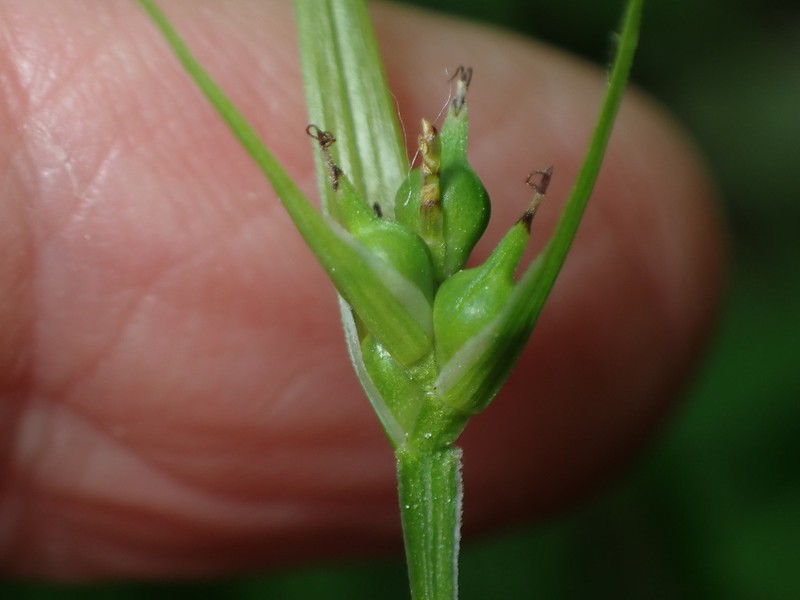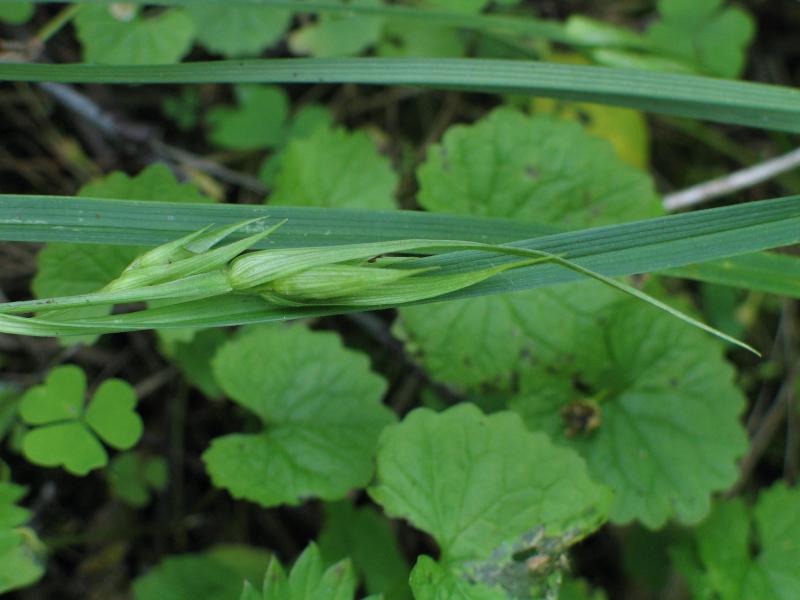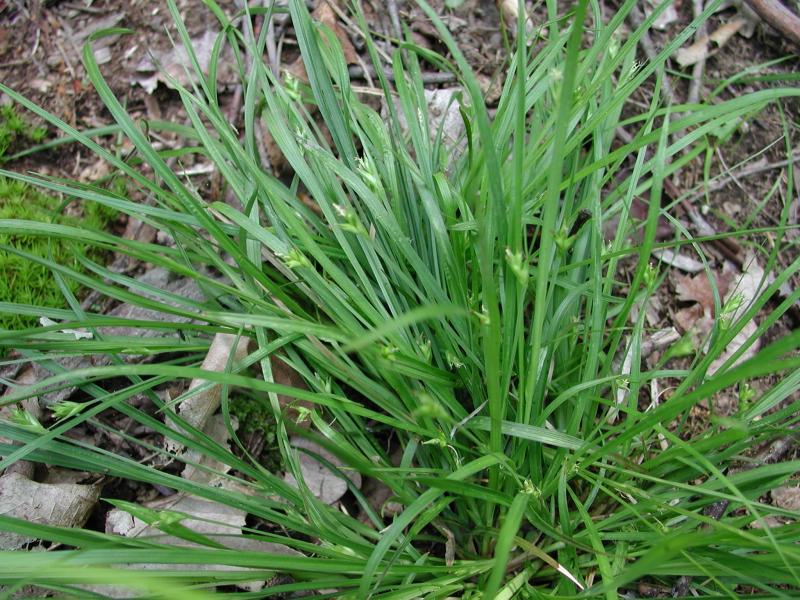James' Sedge
Carex jamesii Schwein.
- Class
- Monocotyledoneae (Monocots)
- Family
- Cyperaceae (Sedge Family)
- State Protection
- Threatened
Listed as Threatened by New York State: likely to become Endangered in the foreseeable future. For animals, taking, importation, transportation, or possession is prohibited, except under license or permit. For plants, removal or damage without the consent of the landowner is prohibited.
- Federal Protection
- Not Listed
- State Conservation Status Rank
- S2S3
Imperiled or Vulnerable in New York - Very vulnerable, or vulnerable, to disappearing from New York, due to rarity or other factors; typically 6 to 80 populations or locations in New York, few individuals, restricted range, few remaining acres (or miles of stream), and/or recent and widespread declines. More information is needed to assign either S2 or S3.
- Global Conservation Status Rank
- G5
Secure globally - Common in the world; widespread and abundant (but may be rare in some parts of its range).
Summary
Did you know?
This species is named for Edwin James (1797-1861) who discovered this plant. Carex jamesii is part of a complex of three species, the other two, C. juniperorum and C. timida, were only recently described (1993 and 2001 respectively).
State Ranking Justification
There are 13 known populations in New York, and at least an additional eight historical sites. This sedge is limited to calcareous areas of central/western New York. It does appear to be threatened by invasive species and does not respond well to logging as other sedges are able to do.
Short-term Trends
Most of the extant populations have only recently been discovered. Since most Carex species seem to get overlooked and often have a short season when they are easy to identify, it is very probable that these recently discovered populations have simply been overlooked in the past. Therefore, no short-term trend is evident.
Long-term Trends
Most populations have only been documented once. There is one population that has been documented for over 100 years. This population is healthy and appears stable. Threats to most populations are minimal but could in the long term have a negative impact on this sedge in New York.
Conservation and Management
Threats
Potential and current threats to this sedge include trampling and grazing by livestock, invasive species, and logging.
Conservation Strategies and Management Practices
Control of exotics, in particular Alliaria petiolata (garlic mustard) and Lonicera morrowii (Morrow's honeysuckle), is needed. While many sedges respond positively to logging, Carex jamesii does not. This is particularly true when logging introduces or further aids exotic species.
Habitat
Habitat
Carex jamesii grows in rich, often calcareous mesic hardwood forests or on alluvial soils of flood plains. It can grow in forests associated with limestone and occasionally in mixed deciduous/coniferous forests (New York Natural Heritage Program 2005). Mesic, rich ravines, slopes, and flood plains in hardwood forests, on lime-rich substrates (Flora of North America 2002). Mesic, rich ravines, slopes, and flood plains in hardwood forests, on lime-rich substrates (Crins et al. 2002). Carex jamesii grows in mesic deciduous woodlands often along streams and usually in uplands, although it occasionally occurs on flood plains. Substrates for this plant are loams that appear to be calcareous and nutrient rich (Naczi and Ford 2001). Limestone woods (Rhoads and Block 2000). Rich woods, especially in calcareous soils (Gleason and Cronquist 1991). Rich deciduous woods and ravines, especially beech-maple and flood plain woods (Voss 1972). Rich, mostly calcareous woods (Fernald 1970).
Associated Ecological Communities
- Appalachian oak-hickory forest
(guide)
A hardwood forest that occurs on well-drained sites, usually on ridgetops, upper slopes, or south- and west-facing slopes. The soils are usually loams or sandy loams. This is a broadly defined forest community with several regional and edaphic variants. The dominant trees include red oak, white oak, and/or black oak. Mixed with the oaks, usually at lower densities, are pignut, shagbark, and/or sweet pignut hickory.
- Beech-maple mesic forest*
(guide)
A hardwood forest with sugar maple and American beech codominant. This is a broadly defined community type with several variants. These forests occur on moist, well-drained, usually acid soils. Common associates are yellow birch, white ash, hop hornbeam, and red maple.
- Floodplain forest
(guide)
A hardwood forest that occurs on mineral soils on low terraces of river floodplains and river deltas. These sites are characterized by their flood regime; low areas are annually flooded in spring, and high areas are flooded irregularly.
- Hemlock-northern hardwood forest
(guide)
A mixed forest that typically occurs on middle to lower slopes of ravines, on cool, mid-elevation slopes, and on moist, well-drained sites at the margins of swamps. Eastern hemlock is present and is often the most abundant tree in the forest.
- Limestone woodland
(guide)
A woodland that occurs on shallow soils over limestone bedrock in non-alvar settings, and usually includes numerous rock outcrops. There are usually several codominant trees, although one species may become dominant in any one stand.
- Maple-basswood rich mesic forest
(guide)
A species rich hardwood forest that typically occurs on well-drained, moist soils of circumneutral pH. Rich herbs are predominant in the ground layer and are usually correlated with calcareous bedrock, although bedrock does not have to be exposed. The dominant trees are sugar maple, basswood, and white ash.
- Rich mesophytic forest*
(guide)
A hardwood or mixed forest that resembles the mixed mesophytic forests of the Allegheny Plateau south of New York but is less diverse. It occurs on rich, fine-textured, well-drained soils that are favorable for the dominance of a wide variety of tree species. A canopy with a relatively large number of codominant trees characterizes this forest. Canopy codominants include five or more of the following species: red oak, red maple, white ash, American beech, sugar maple, black cherry, cucumber tree, and black birch.
* probable association but not confirmed.
Associated Species
- Acer nigrum (black maple)
- Acer saccharum (sugar maple)
- Allium canadense
- Arisaema triphyllum ssp. triphyllum (common jack-in-the-pulpit)
- Cardamine concatenata (cut-leaved toothwort)
- Carex albursina (white bear sedge)
- Carex blanda (eastern woodland sedge)
- Carex laxiculmis var. copulata (coupled sedge)
- Carex oligocarpa (few-fruited sedge)
- Carya cordiformis (bitternut hickory)
- Carya ovata
- Caulophyllum thalictroides (blue cohosh, late blue cohosh)
- Diplazium pycnocarpon
- Erythronium americanum
- Floerkea proserpinacoides (false mermaid-weed)
- Fraxinus americana (white ash)
- Galium aparine (cleavers)
- Geranium maculatum (wild geranium)
- Hydrastis canadensis (golden-seal)
- Jeffersonia diphylla (twinleaf)
- Juglans nigra (black walnut)
- Lindera benzoin (spicebush)
- Mertensia virginica (eastern bluebells)
- Osmorhiza longistylis (aniseroot, long-styled sweet-cicely)
- Ostrya virginiana (hop hornbeam, ironwood)
- Persicaria virginiana (jumpseed)
- Poa alsodes (grove blue grass)
- Podophyllum peltatum (may-apple)
- Polystichum acrostichoides (Christmas fern)
- Quercus rubra (northern red oak)
- Ranunculus recurvatus
- Sanguinaria canadensis (bloodroot)
- Tilia americana
- Toxicodendron radicans ssp. radicans (eastern poison-ivy)
- Trillium grandiflorum (white trillium)
- Valerianella chenopodiifolia (goosefoot corn-salad)
- Waldsteinia fragarioides
Range
New York State Distribution
This sedge is limited to the calcareous areas of central and western New York, particularly the Genesee River region and along the Onondaga Escarpment. It also appears to occur in Jefferson County.
Global Distribution
Carex jamesii occurs from northwestern New York west to southern Ontario, southern Wisconsin, and southeastern Minnesota south to western South Carolina, northern Alabama, northern Mississippi, Arkansas, and eastern Oklahoma. It is very common in most of this range except east of Ohio, Kentucky, Tennessee, and Alabama where it is rare (Naczi and Ford 2001).
Identification Comments
General Description
A densely tufted grass-like plant, this sedge has deep-green leaves that are 1.2-3.5 mm wide. The leaves are up to 59 cm long. The flowers and fruits are borne as clusters (spikes) 6.4-15.7 mm long at the tip of stalks that are slightly to much shorter than the leaves. Although the spikes are relatively small and inconspicuous they should be sought for positive identification.
Identifying Characteristics
This densely cespitose perennial Carex has leaves that are flat to barely plicate and 1.2-3.1(-3.5) mm wide. Reproductive shoots produce one terminal spike on culms 5.7-41 cm tall, which are dilated at their apex. At the base of the culms (0-)1-3 lateral spikes are produced on peduncles 2.7-14 cm long, which are also dilated at their apex. Spikes are androgynous with 3-13 staminate flowers and (1-)2-3(-4) pistillate flowers per spike. There are no bracts subtending the spikes. The proximal-most pistillate scale of the terminal spike is leaflike and 1.2-11.9 cm long and 1.4-3.0 mm wide at the base. Perigynia abruptly taper to a distinct beak.
Best Life Stage for Proper Identification
This species is most easily identified when it has immature to mature fruits. Collected specimens should include the entire plant including roots, leaves, and fruit.
Similar Species
Carex jamesii is a member of section Phyllostachyae. In New York there are two (C. backii and C. willdenowii) and perhaps a third (C. juniperorum) species that are also in section Phyllostachyae and are somewhat similar morphologically.
Carex jamesii can be separated from C. backii by its narrower pistillate scales, 1.4-3.0 mm wide, which do not completely conceal the perigynia compared to 2.0-6.5 mm wide, which completely conceal the perigynia for C. backii; and 3-13 staminate flowers per spike compared to 2-3 for C. backii.
Carex jamesii can be separated from C. willdenowii by its terminal spikes having 1-4 perigynia compared to 3-9 for C. willdenowii; perigynia abruptly tapering to a beak compared to more gradually tapering to a beak in C. willdenowii; and staminate scales truncate to sub-truncate at the apex compared to obtuse at the apex for C. willdenowii.
Carex jamesii can be separated from C. juniperorum by its tallest culms being 14-41 cm long compared to 3.3-9.1 cm long for C. juniperorum; terminal spikes with 1-4 perigynia compared to 4-9 perigynia for C. juniperorum; and wider leaf blades with green margins as opposed to hyaline margins for C. juniperorum.
Best Time to See
The species is in fruit in New York from late May to late July. By July most fruits have shed making identification harder. The best time to survey for this species is late May through June.
- Fruiting
The time of year you would expect to find James' Sedge fruiting in New York.
James' Sedge Images
Images of Similar Species
Taxonomy
James' Sedge
Carex jamesii Schwein.
- Kingdom Plantae
- Phylum Anthophyta
- Class Monocotyledoneae
(Monocots)
- Order Cyperales
- Family Cyperaceae (Sedge Family)
- Order Cyperales
- Class Monocotyledoneae
(Monocots)
- Phylum Anthophyta
Additional Common Names
- Grass Sedge
- Nebraska Sedge
- Sedge
Synonyms
- Carex steudelii Kunth
Comments on the Classification
Recent work has determined that there are two additional previously undescribed species (C. juniperorum and C. timida) in the C. jamesii complex. Carex juniperorum which was described in 1993 is highly localized in distribution, known from only three disjunct areas (southeastern Ontario, southwestern Virginia, and southern Ohio to adjacent northeastern Kentucky). The Ontario sites are close to New York and there is some possibility that C. juniperorum will be discovered in New York. Carex timida which was described in 2001 occurs south and west of New York (Catling et al. 1993, Naczi and Ford 2001).
Additional Resources
Best Identification Reference
Crins, W.J., R.F.C. Naczi, A.A. Reznicek, and B.A. Ford. 2002. Carex Linnaeus sect. Phyllostachyae Tuckerman ex Kükenthal. Pages 558-563 in Flora of North America Editorial Committee (editors), Flora of North America, north of Mexico, Volume 23, Magnoliophyta: Commelinidae (in part): Cyperaceae. Oxford University Press, New York, New York, USA. 608pp + xxiv.
Other References
Catling, P.M., A.A. Reznicek, and W.J. Crins. 1993. Carex juniperorum (Cyperaceae), a new species from northeastern North America, with a key to Carex sect. Phyllostachys. Systematic Botany 18(3): 496-501.
Fernald, M.L. 1950. Gray's manual of botany. 8th edition. D. Van Nostrand, New York. 1632 pp.
Flora of North America Editorial Committee. 2002. Flora of North America, North of Mexico. Volume 23. Magnoliophyta: Commelinidae (in part): Cyperaceae. Oxford University Press, New York. 608 pp.
Gleason, Henry A. and A. Cronquist. 1991. Manual of Vascular Plants of Northeastern United States and Adjacent Canada. The New York Botanical Garden, Bronx, New York. 910 pp.
Holmgren, Noel. 1998. The Illustrated Companion to Gleason and Cronquist's Manual. Illustrations of the Vascular Plants of Northeastern United States and Adjacent Canada. The New York Botanical Garden, Bronx, New York.
Mitchell, Richard S. and Gordon C. Tucker. 1997. Revised Checklist of New York State Plants. Contributions to a Flora of New York State. Checklist IV. Bulletin No. 490. New York State Museum. Albany, NY. 400 pp.
Naczi, R. F. and R. A. Ford. 2001. Systematics of the Carex jamesii complex (Cyperaceae: Sect. Phyllostachyae). Sida 19(4): 853-884.
New York Natural Heritage Program. 2010. Biotics database. New York Natural Heritage Program. New York State Department of Environmental Conservation. Albany, NY.
New York Natural Heritage Program. 2024. New York Natural Heritage Program Databases. Albany, NY.
Reschke, Carol. 1990. Ecological communities of New York State. New York Natural Heritage Program, New York State Department of Environmental Conservation. Latham, NY. 96 pp. plus xi.
Rhoads, Ann F. and Timothy A. Block. 2000. The Plants of Pennsylvania, an Illustrated Manual. University of Pennsylvania Press, Philadelphia, PA.
Voss, E.G. 1972. Michigan Flora, Part I. Gymnosperms and Monocots. Cranbrook Institute of Science Bulletin 55 and the University of Michigan Herbarium. Ann Arbor. 488 pp.
Weldy, T. and D. Werier. 2010. New York flora atlas. [S.M. Landry, K.N. Campbell, and L.D. Mabe (original application development), Florida Center for Community Design and Research http://www.fccdr.usf.edu/. University of South Florida http://www.usf.edu/]. New York Flora Association http://newyork.plantatlas.usf.edu/, Albany, New York
Links
About This Guide
Information for this guide was last updated on: November 4, 2022
Please cite this page as:
New York Natural Heritage Program. 2024.
Online Conservation Guide for
Carex jamesii.
Available from: https://guides.nynhp.org/james-sedge/.
Accessed July 26, 2024.
